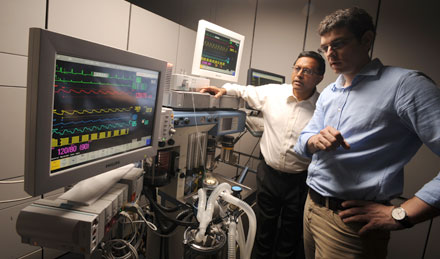Style and Culture
In the Research Laboratory of Electronics (RLE) at the Massachusetts Institute of Technology (MIT), interdisciplinary interaction characterizes both daily activities and the long-range direction of research. A tension between individual focus and intergroup collaborations leads to highly specialized strengths as well as collective efforts that arise from the mutual interest of many investigators.

Research at RLE often involves developing innovative technological tools to reveal new insights into the physical world and its abstract models. The Laboratory seeks, on one hand, to develop basic understanding and intellectual means to model complex phenomena and, on the other hand, to create a foundation for building new high-performance technologies which can be used to further research progress.
Major Themes
RLE currently pursues seven major research themes.
Atomic Physics. In this theme, an extensive range of investigations are carried out in ultracold atoms, quantum condensed gases, and atom optics. New methods are being developed for manipulating and probing Bose-Einstein condensed atomic gases and exploring ultracold interactions and collision dynamics. Additional work focuses on atom lasers, atom interferometry, atom waveguides, surface physics, quantum reflection, many body physics in lower dimensions, plasmas, and electromagnetics.
Information Science and Systems. This theme includes a complete range of activities over all aspects of electronics, including structures, devices, and circuits, analog and digital systems, MEMs and bioMEMs, nanotechnologies, numerical and computational simulation and prototyping, biologically-inspired systems, digital signal processing, advanced telecommunications, medical imaging, and the exploration of fundamental issues in wireless networking and devices.
Quantum Computation and Communication. This area of emphasis features efforts in quantum information processing and transmission, with extensive new initiatives in quantum computation, superconducting circuits and understanding and exploiting quantum teleportation.
Energy, Power and Electromagnetics. This theme comprises work in excitonics, studies in the absorption and emission of light, solar cells, disordered and low-dimensional materials, complex nanostructures, organic LEDs, nanowires, hybrid organic-inorganic materials, organic structures and devices, power electronics, signal level control circuits and electronics, system identification and control, continuum electromechanics, and high voltage and insulation research.
Photonic Materials Devices and Systems. This theme includes significant efforts in integrated photonic devices, modules and systems for applications in communications and sensing, femtosecond optics, laser technologies, photonic bandgap fibers and devices, materials fabrication, laser medicine and medical imaging, and millimeter-wave and terahertz devices.
Nanoscale Materials, Devices and Systems. This theme comprises research in fabricating surface structures at nano scales, nanomagnetics and microphotonics, periodic structures, superconductive materials, and carbon nanotubes.
Biomedical Science and Engineering. This theme encompasses thrusts in bio-inspired electronics and neural prostheses; nano- and micro-technologies for understanding and manipulating biological processes at the cellular and molecular level; imaging and computational modeling of disease and neuro-anatomical processes; and communication biophysics, including language, speech, hearing and haptics.
Research directions are driven bottom-up by the natural interests of individual principal investigators rather than mandated top-down in a centralized fashion. The Laboratory’s organization into small, discrete groups allows rapid adaptation and recombination of efforts to exploit new discoveries and to work with a wide variety of collaborating investigators outside of RLE and institutions outside of MIT.
Sponsors
The annual dollar volume of RLE activities is approximately $100M. Our principal sponsors are:
The Department of Defense (DOD).
The agencies of the DOD, which include the Defense Advanced Research Projects Agency (DARPA), the Office of Naval Research (ONR), the Air Force Office of Scientific Research (AFOSR), and Army Research Office (ARO), provide approximately 33% of the sponsored research funding in RLE. Projects range from single investigator grants to large, multi-investigator programs.
The National Institutes of Health (NIH).
The NIH provide approximately 20% of RLE’s sponsored research funding, and supports efforts in communication biophysics, laser medicine, and neural prostheses.
The National Science Foundation (NSF).
The NSF provides approximately 15% of the sponsored research funding in RLE, with support ranging from single investigator grants to the large MIT-Harvard Center for Ultracold Atoms.
Industry.
RLE collaborations with industry in multiple application areas support approximately 10% of the Laboratory’s activities.
Collaborative projects with peer non-profit institutions.
Approximately 20% of RLE’s sponsored research funding comes in the form of collaborative agreements with other institutions and universities, most of which are funded by the DOD or NIH.
Remaining RLE activities are funded from other Federal agencies, foundations, MIT Lincoln Laboratory, or by the discretionary resources of RLE and its investigators.
